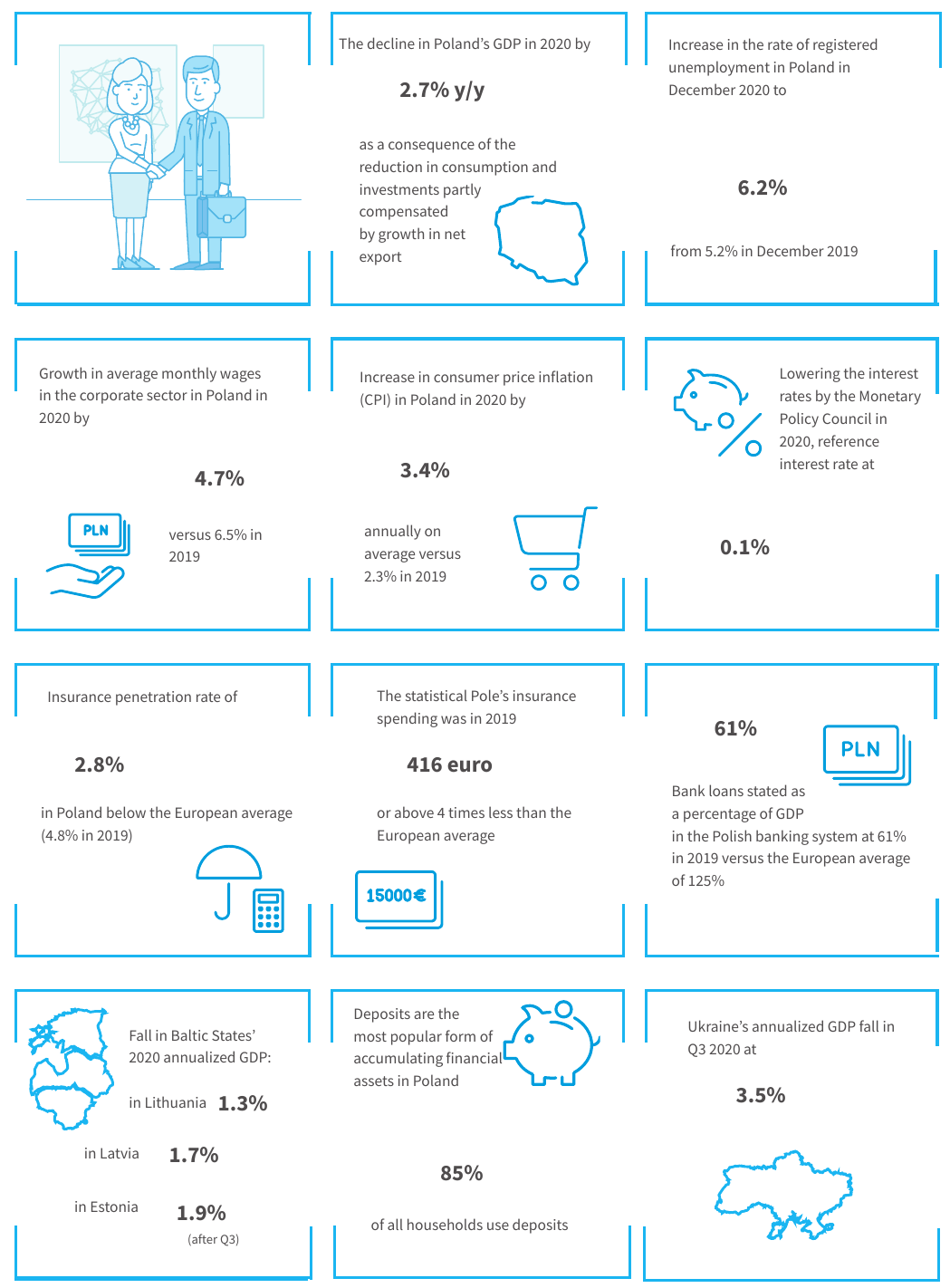Navigation Map
- strategy (insurance, health, investments, finances);
- sustainable development (sales, employees, social responsibility, natural environment and ethics).
PRACTICES
In the Chapter
GRIs
In the Chapter
GRIs
In the Chapter
List of GRIs
In the Chapter
GRIs
In the Chapter
GRIs
In the Chapter
GRIs
In the Chapter
GRIs
In the Chapter
GRIs
In the Chapter
GRIs
In the Chapter
GRIs
In the Chapter
Operating model
GRIs
- About the report
- Results
- Comment on the financial results for 2020
- Major factors contributing to the consolidated financial result
- PZU Group’s income
- PZU Group’s claims paid and technical provisions
- PZU Group’s acquisition and administrative expenses
- Drivers and atypical events affecting the results
- PZU Group’s asset and liability structure
- Contribution made by the market segments to the consolidated result
- Issuer’s financial results – PZU (PAS)
- Impact of the COVID-19 pandemic on the PZU Group’s results
- Business strategy (2017-2020)
- CSR strategy(2017-2020)
- Supplementary information and notes
- 1. Introduction
- 2. Composition of PZU Group
- 3. Shareholder structure
- 4. Composition of the Management Board, Supervisory Board and PZU Group Directors
- 5. Key accounting policies, key estimates and judgments
- 5.1 Impact of the COVID-19 pandemic on the estimates and assumptions
- 5.2 Changes in accounting policies and estimates, errors from previous years
- 5.3 Amendments to the applied IFRS
- 5.4 Explanation of differences between the 2019 annual consolidated financial statements and these consolidated financial statements
- 5.5 Consolidation principles
- 5.6 Measurement of transactions and balances denominated in foreign currencies and FX rates used
- 5.7 Purchase method
- 5.8 Classification of insurance contracts in accordance with IFRS 4
- 6. Segment reporting
- 7. Risk management
- 8. Equity management
- 9. Fair value
- 10. Gross written premium
- 11. Fee and commission income
- 12. Interest income calculated using the effective interest rate
- 13. Other net investment income
- 14. Result on derecognition of financial instruments and investments
- 15. Movement in allowances for expected credit losses and impairment losses on financial instruments
- 16. Net movement in fair value of assets and liabilities measured at fair value
- 17. Other operating income
- 18. Claims and movement in technical provisions
- 19. Fee and commission expense
- 20. Interest expenses
- 21. Acquisition costs
- 22. Administrative expenses
- 23. Employee expenses
- 24. Other operating expenses
- 25. Income tax
- 26. Earnings per share
- 27. Goodwill
- 28. Intangible assets
- 29. Other assets
- 30. Deferred acquisition cost
- 31. Property, plant and equipment
- 32. Investment property
- 33. Entities carried by the equity method
- 34. Loan receivables from clients
- 35. Financial derivatives
- 36. Investment financial assets
- 37. Receivables
- 38. Impairment of financial assets
- 39.Cash and cash equivalents
- 40. Equity attributable to equity holders of the parent
- 41. Technical provisions
- 42. Subordinated liabilities
- 43. Liabilities on the issue of own debt securities
- 44. Liabilities to banks
- 45. Liabilities to clients under deposits
- 46. Other liabilities
- 47. Provisions
- 48. Deferred income tax
- 49. Assets and liabilities held for sale
- 50. Lease
- 51. Assets securing receivables, liabilities and contingent liabilities
- 52. Contingent assets and liabilities
- 53. Offsetting financial assets and financial liabilities
- 54. Notes to the consolidated cash flow statement
- 55. Disputes
- 56. Transactions with related entities
- 57. Headcount
- 58. Other information
- Financial data (2019-2020)
- Financial data (2016-2020) Focus on: Results - check the highlights of the year!
- Comment on the financial results for 2020
- Market and business
- External environment
- Business model
- Structure of the Group
- Operating model
- Brand management
- Insurance
- Non-life insurance (PZU, LINK4 and TUW PZUW)
- Life insurance (PZU Życie)
- Insurance (international operations)
- Investments
- Investments (PZU TFI)
- Investments (PTE PZU)
- Health
- Health (health companies)
- Banking and strategic partnerships
- Banking (Bank Pekao, Alior Bank)
- Other operating areas
Focus on: Market and business - check the highlights of the year!
- Capitals (IIRC)
- Strategy and outlook 2021+
- Risk and ethics
- Objective of risk management
- Risk management system
- Risk appetite
- Risk management process
- PZU Group's risk profile
- ESG risks
- Risk vulnerability
- Reinsurance operations
- Capital management
- Ethical foundations of doing business
- Preventing corruption and conflicts of interest
- Whistleblowing System
- Transaction security
- Tax transparency
- Cooperation with suppliers Focus on: Risk and ethics - check the highlights of the year!
- Corporate governance
- Application of corporate governance rules
- System of control in the process of preparing financial statements
- Audit firm auditing the financial statements
- PZU's share capital and its shareholders
- Rules for amending the Company's Articles of Association
- Shareholder Meeting and shareholder rights
- Supervisory Board and Management Board
- Compensation paid to members of supervisory and management bodies
- Diversity policy Focus on: Corporate governance - check the highlights of the year!
- Shares and bonds
- Equity and bond market
- PZU's share price
- Banking sector on the Warsaw Stock Exchange
- PZU's investor relations
- Analysts' recommendations regarding PZU's shares
- PZU Group's Capital and Dividend Policy
- Debt financing of PZU, Bank Pekao and Alior Bank
- Rating
- Calendar of PZU's major corporate events in 2021 Focus on: Shares and bonds - check the highlights of the year!
External environment in the Baltic States and Ukraine

Lithuania
In Q4 2020, seasonality-adjusted GDP decreased by 1.3% y/y. While public consumption showed a favorable growth rate, the other GDP components recorded a decline. It is expected that the COVID-19 pandemic will continue to exert an adverse impact on the economy, yet the economic activity should improve at the beginning of Q2 2021.
In December 2020, the unemployment rate was 10.1%, thus by 3.7 p.p. more than the year before. The COVID-19 pandemic deteriorated to a significant extent the situation on the labor market. Employees affected most were those from the services sector and with low qualifications. Unemployment had a slightly weaker impact on commerce, construction industry, transport and production activity. At the same time, a high supply of jobs is being observed, which in the situation of growing unemployment shows structural changes in the labor market. On the one hand, the number of people looking for work has increased considerably; on the other hand, companies are not able to fill the existing vacancies. Structural unemployment may therefore relatively quickly change into long-term unemployment, which poses a threat to the labor market and to prospects of economic growth.
In 2020, inflation subsided to low levels, with the annual rate of 0.2%. At the beginning of the crisis caused by the COVID-19 pandemic, the inflation was considerably reduced as a result of the global decrease in demand for energy goods and their prices; with the second wave of the pandemic, the inflation remained lower because of the already visible impact of the crisis on prices of services.
Latvia
Latvia’s GDP fell down in Q4 2020 by 1.7% (annual data, adjusted for seasonality), i.e. lower than in Q2, when the decrease was 8.9%, and in Q3, when it reached 2.6%. The data suggest that the economy recovered faster – the production sectors did not show a decrease in production, and the service sectors quite quickly restarted business activity. The major cause of the economic downturn in 2020 was a decrease in private consumption resulting from the restrictions introduced because of the COVID-19 pandemic, which significantly limited business activities. That was at the same time prevented by the increase in expenditures on public consumption. In terms of sectors, the downturn was most marked by a decline in the transport sector, business connected with accommodation and catering as well as cultural, entertainment and leisure areas. A growth was observed only in the construction industry, agriculture, public administration and defense.
Data of the Latvian statistical office show that in December 2020, the actual unemployment rate was 8.3%, i.e. it was higher by 1.7 p.p. than in December 2019. The number of unemployed increased by 16.8 thousand y/y and reached 80.5 thousand at the end of 2020.
The annual inflation rate was -0.5% in December 2020, commodity prices dropped by 1.4%, whereas prices of services grew by 1.6%. Compared to December 2019, the average level of consumer prices was mainly affected by a fall in the prices of commodities and services related to transport, housing maintenance, clothing and footwear. On the other hand, price increases were recorded for food, tobacco products and non-alcoholic and alcoholic beverages, as well as for leisure, cultural and catering services and in the area of healthcare.
Estonia
In Q3 2020, when the restrictions imposed in the spring because of the COVID-19 pandemic, the annual GDP growth rate in Estonia was at -1.9%. After the first wave of the coronavirus, the business activity recovered quite quickly but unevenly. The reduction in restrictions contributed to a rapid recovery of private consumption but exports were still dependent on restrictions in other countries. The adverse influence on the economic situation was seen in the tourism sector, hit hardest by the crisis.
At the end of 2020, the unemployment rate stood at 7.4%, up 3.3 p.p. compared to December 2019. The economic recovery, with the simultaneous shortage of workforce, was conducive to an increase in the average salaries and wages, which was 3.2% in Q3.
The annual consumer price index (CPI) stood at -0.4%. Prices reacted strongly to the outbreak of the pandemic in the spring and to the consequent rapid decrease in oil prices. By November, energy prices fell (mostly fuels), dramatically increasing only towards the end of the year. From the beginning of the pandemic, food prices grew, which also resulted from a relatively quick increase in prices in external markets. In Q4, the consumer price index stabilized at -0.8%.
Ukraine
After years of political and economic tensions, the Ukrainian economy overcame the signs of crisis and, before the outbreak of the COVID-19 pandemic, went into a stage of recovery, although with a modest growth rate. In 2020, however, as a result of the pandemic, there was a decrease – in the third quarter, the annual GDP growth rate remained at -3.5%. The annual inflation rate was 5% in December, thus reaching the center of the target range of 5.0% ±1 p.p. defined for 2020. The unemployment rate rose to 9.3% in September 20201 from 8.2% in December 2019.
After 11 months of 2020, a negative balance of foreign trade in goods and services was recorded (USD -1.3 billion). The conflict in the eastern part of Ukraine is still harmful for the economy. The loss of control over resources in this part of the country significantly reduced Ukraine’s export capabilities because of disruptions connected with mining production and with electricity generation.

1 according to the definition of the International Labor Organization (ILO)
Investor Relations Team
e-mail: IR@pzu.pl
Magdalena Komaracka, IR Director, tel. +48 (22) 582 22 93
Piotr Wiśniewski, IR Manager, tel. +48 (22) 582 26 23
Aleksandra Jakima-Moskwa, tel. +48 (22) 582 26 17
Aleksandra Dachowska, tel. +48 (22) 582 43 92
Piotr Wąsiewicz, tel. +48 (22) 582 41 95
